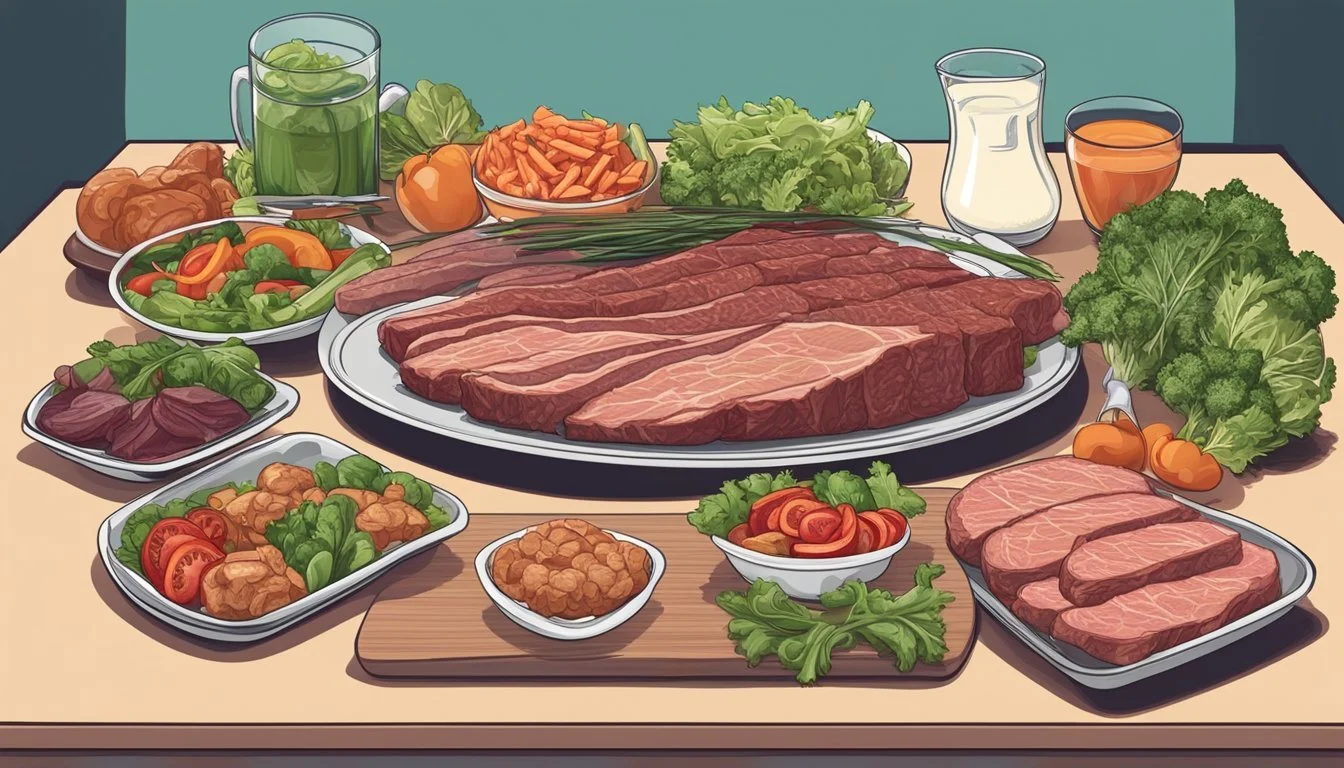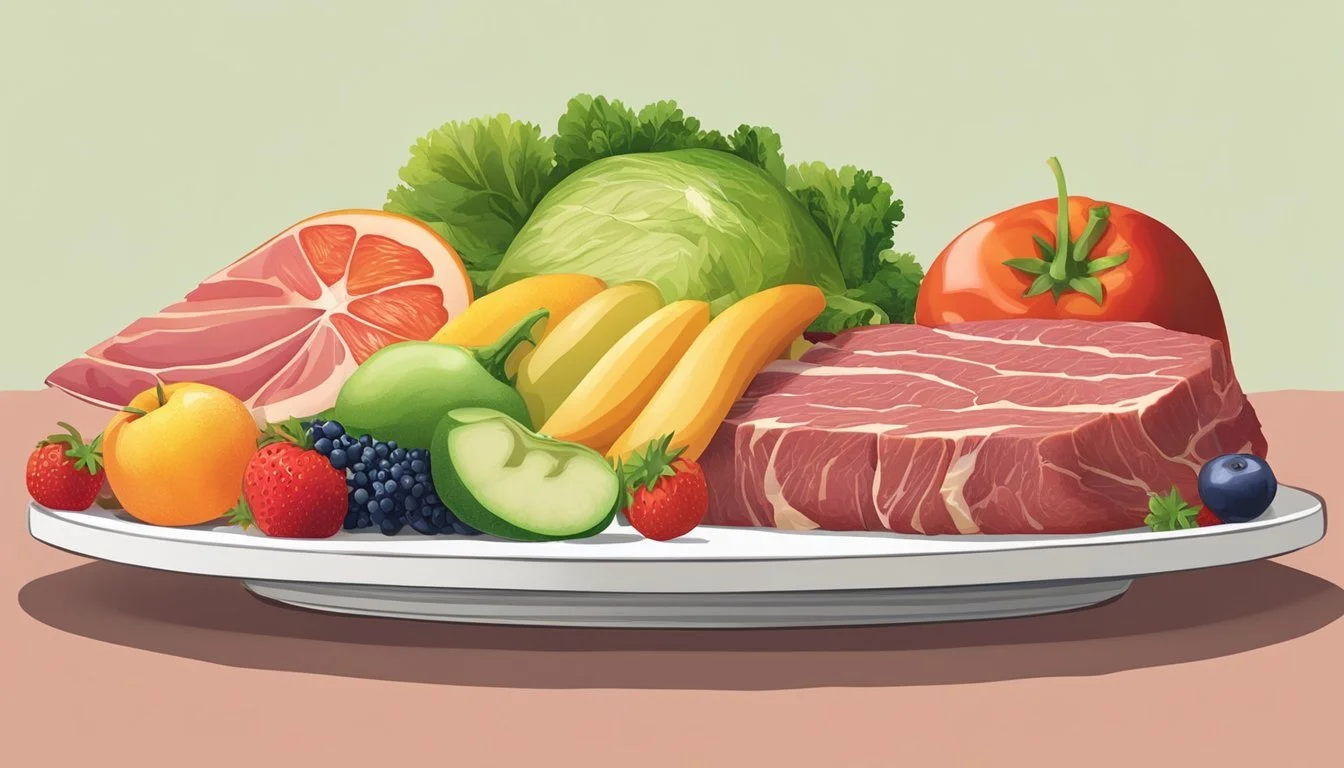Carnivore Diet vs. The Biggest Loser Diet
Comparing Reality TV Meal Plans
When discussing modern dietary strategies, particularly those popularized by reality TV, two notable examples are the Carnivore and The Biggest Loser diets. The Carnivore Diet, as the name suggests, involves consuming exclusively animal products with an emphasis on meat and fat, and it has gained a following for its simplicity and purported health benefits. Proponents of the Carnivore Diet claim improvements in weight loss, mental clarity, and reduction of inflammation, although these claims are met with skepticism by many nutrition experts.
On the other side of the spectrum, The Biggest Loser Diet, derived from the well-known reality TV show, focuses on calorie restriction, balanced nutrition, and regular physical exercise. This diet emphasizes portion control, lean protein, whole grains, and vegetables, aiming to create a sustainable approach to weight loss and healthy living. While it has received positive feedback for promoting lifestyle changes and steady weight loss, critics argue about the diet's long-term effectiveness and the show's approach to rapid weight loss.
Both diets capture the public's interest through their associated media platforms, promising significant results but following distinctly different philosophies. As they circulate through social and traditional media, it's essential to examine their potential health impacts, nutritional adequacy, and suitability for long-term lifestyle adaptation. Their effectiveness and safety have become subjects of debate among health professionals, with each diet offering unique advantages and drawbacks.
Understanding Diets
This section provides an analytical overview of two distinct dietary approaches: the Carnivore Diet, which focuses on animal-based foods, and the Biggest Loser Diet, which emphasizes calorie control and a balanced intake of macronutrients.
Defining the Carnivore Diet
The Carnivore Diet is a regimen that typically includes only animal products—meat, fish, eggs, and certain dairy products. Proponents argue it can lead to weight loss and improved health outcomes. The diet's composition is high in protein and fats, but it excludes carbohydrates, fiber, and sources of some vitamins and minerals such as Vitamin C. It is important to note that while some individuals report positive changes in their metabolism or reduced symptoms of conditions like diabetes, the diet's long-term effects on heart disease are not well documented. Consulting a healthcare provider before starting such an extreme low-carb plan is essential.
Exploring the Biggest Loser Diet
The Biggest Loser Diet, by contrast, promotes a calorie deficit to encourage weight loss, balancing proteins, fats, and carbohydrates. It incorporates a variety of foods to ensure intake of fiber, vitamins, and minerals necessary for a healthy lifestyle. The structured diet plan derived from the show includes meals designed by trainers and nutritionists to avoid insulin spikes and support sustainable weight management. A typical day's meals would be calorically restricted but nutritionally balanced, aiming to prevent diabetes and reduce the risk of heart disease. This approach to dieting is often seen as more attainable for the average person looking for a balanced diet.
Nutritional Profile Comparisons
When comparing the Carnivore Diet and The Biggest Loser Diet, it is essential to thoroughly assess their nutritional profiles, particularly focusing on macro and micronutrients, and how these may influence health and disease.
Macro and Micronutrient Breakdown
The Carnivore Diet is high in protein and fat, including saturated fat, mainly sourced from meat, organs, and other animal products. Seafood, a component of the diet, provides essential nutrients like omega-3 fatty acids, iron, vitamin B12, and zinc. However, it completely excludes fiber, as it contains no plant-based foods.
The Biggest Loser Diet emphasizes a balance of macronutrients with a reduced calorie intake. It includes fruits, vegetables, whole grains, lean proteins, and low-fat dairy products. This provides a broader spectrum of vitamins and minerals and is generally lower in fat compared to the Carnivore Diet.
Here is a list comparing the nutrient profiles of the Carnivore Diet and The Biggest Loser Diet:
Nutrient: Protein
Carnivore Diet: High (meat, seafood)
The Biggest Loser Diet: Varied (meat, dairy, plants)
Nutrient: Fat
Carnivore Diet: High (mostly saturated)
The Biggest Loser Diet: Lower, varied types
Nutrient: Fiber
Carnivore Diet: Absent
The Biggest Loser Diet: Present
Nutrient: Essential Nutrients
Carnivore Diet: Present (Vitamin B12, iron, zinc)
The Biggest Loser Diet: More diverse (from both plants and animals)
Impact on Health and Disease
The high intake of animal products and saturated fat in the Carnivore Diet has been a point of contention among nutrition experts due to potential associations with heart disease and cancer. Conversely, the meat content can enhance mental clarity and blood sugar control due to steady insulin levels, although these benefits are anecdotal and more research is required.
The Biggest Loser Diet, focusing on variety and moderation, may aid in managing obesity and chronic disease by promoting a balanced intake of all necessary nutrients. A diverse range of foods contributes to overall nutrition and can support long-term health. However, portion control and caloric restriction are key components for effectiveness.
Here is a list comparing the health aspects of the Carnivore Diet and The Biggest Loser Diet:
Health Aspect: Heart Disease
Carnivore Diet: Risk may increase (high saturated fat)
The Biggest Loser Diet: Potential decrease (balanced fat intake)
Health Aspect: Cancer
Carnivore Diet: Possible associations with red meat
The Biggest Loser Diet: Less risk (variety of foods)
Health Aspect: Obesity
Carnivore Diet: Low-carb could aid weight loss
The Biggest Loser Diet: Calorie control designed for weight loss
Health Aspect: Chronic Disease
Carnivore Diet: Limited data available
The Biggest Loser Diet: Diet may aid prevention and management
Health Aspect: Mental Clarity/Blood Sugar Control
Carnivore Diet: Anecdotal benefits (steady insulin)
The Biggest Loser Diet: Balanced diet may not lead to extremes in blood sugar
These dietary approaches vary significantly and should be chosen with consideration of their contrasting effects on the body's nutritional status.
Dietary Implementation
Implementing the Carnivore Diet or The Biggest Loser Diet requires careful consideration of meal planning and food procurement strategies.
Practical Meals and Recipes
Carnivore Diet:
Breakfast: Scrambled eggs with a side of bacon.
Lunch: Grilled grass-fed steak with a side of liver pâté.
Dinner: Roasted chicken breasts with a serving of bone broth.
The Biggest Loser Diet:
Breakfast: Oatmeal with chopped apple and a sprinkle of cinnamon.
Lunch: Grilled chicken breast with a green salad (including plant-based foods) and a slice of whole-grain bread.
Snack: Low-fat yogurt with berries.
Dinner: Tofu and veggie stir-fry with brown rice.
Note: For the Carnivore Diet, meals exclusively comprise animal products such as meats, eggs, and fish, focusing heavily on the inclusion of organ meats like liver for their nutrient density. The Biggest Loser Diet incorporates a balance of macronutrients, including lean meats, full-fat dairy, seafood, and a moderate amount of plant-based foods.
Shopping and Food Preparation
For both diets, the approach to shopping and food preparation is distinct:
Carnivore Diet:
Shop primarily in the meat section, opting for grass-fed beef, organ meats such as liver, and a variety of fish and seafood.
Preparation is typically simple, focusing on grilling, roasting, or pan-frying meats with minimal seasoning, mostly salt.
It may be perceived as boring due to the lack of different flavors and can be more expensive due to the emphasis on high-quality animal products.
The Biggest Loser Diet:
Shopping lists will be more diverse, including lean meats, full-fat dairy, fresh fruits like apples, vegetables, and whole grains.
Preparation involves more steps, including measuring portion sizes to stay under a specific calorie count, which is critical for this weight-loss plan.
Recipes promote a healthier lifestyle by incorporating various food groups, which can prevent meals from becoming monotonous.
Incorporating these diets into daily life involves consideration of not just meal content but also the logistics of acquisition, cost, and meal preparation. Each diet has specific requirements that can affect the overall ease of maintaining it in the real world.
Health and Weight Management
In comparing the Carnivore Diet and The Biggest Loser Diet, it is essential to evaluate their implications on health and weight management. This includes observing weight loss outcomes and how each diet manages nutrition and energy levels to sustain healthy lifestyle changes.
Weight Loss Outcomes
The Carnivore Diet is a low-carb, high-protein diet that may lead to weight loss due to ketosis, a state where the body burns fats instead of carbohydrates for energy. On this diet, individuals report short-term weight loss, which could be attributed to a reduction in calorie intake and a metabolic shift. However, potential weight regain is a concern due to the restrictive nature of the diet and the difficulty in maintaining such eating patterns long-term.
The Biggest Loser Diet focuses on calorie restriction combined with exercise. The weight loss reported by followers is largely due to creating a significant calorie deficit. While effective for losing weight initially, participants must be wary of the risk of weight regain, especially if they return to previous eating habits.
Managing Nutrition and Energy Levels
The Carnivore Diet may cause fluctuations in energy levels when first adapting to the low availability of carbohydrates. Proponents argue that mental clarity and stable blood sugar levels are achieved once the body has adapted to using fat for fuel. However, a healthcare provider should be consulted to monitor health effects, due to concerns about nutrient deficiencies and the long-term health effects of a high intake of saturated fats.
On the other hand, The Biggest Loser Diet aims to maintain energy levels by balancing nutrient-dense and low-calorie foods across meals. This diet encourages the consumption of whole grains, lean proteins, and a variety of fruits and vegetables, ensuring that the body receives essential nutrients for optimal function.
Both diets require careful consideration and often the support of a healthcare provider to ensure that nutritional needs are being met while pursuing weight loss goals. Regular exercise is also a critical component of both diets for health and weight management, but their nutritional philosophies significantly differ.
Risks and Considerations
The risks and considerations associated with the Carnivore Diet and The Biggest Loser Diet have distinct implications for long-term health and sustainability. This section examines potential health concerns and the long-term viability of these diets when applied in real-world settings.
Potential Health Risks
Carnivore Diet:
Heart Disease and High Blood Pressure: A diet high in animal protein and processed meats may increase the risk of heart disease and high blood pressure due to a higher intake of saturated fats and cholesterol.
Nutrient Deficiencies: Exclusive consumption of animal products can lead to deficiencies in essential nutrients found in plant foods, such as fiber, certain vitamins, and antioxidants.
Kidney Problems: Increased protein intake can strain the kidneys, and those with existing kidney conditions should proceed with caution.
Cancer Risk: Some studies suggest a correlation between high consumption of red and processed meats and an increased risk of colon cancer.
The Biggest Loser Diet:
Rapid Weight Loss Concerns: Drastic calorie restriction may trigger short-term health issues such as gallstone formation, and rapid weight loss can affect lean muscle mass.
Blood Sugar and Carbs: While the diet includes carbs, the reduced calorie intake can lead to dips in blood sugar levels, which may be problematic for individuals with diabetes.
Long-term Sustainability
Carnivore Diet:
Social and Lifestyle Impact: The highly restrictive nature of a meat-only diet can impede social interactions centered around food and may be difficult to maintain long-term.
Inflammation and Autoimmune Conditions: Some proponents argue for benefits in reducing inflammation and ameliorating symptoms of autoimmune conditions, but evidence is anecdotal.
The Biggest Loser Diet:
Obesity Rebound: There is a risk of regaining weight after stopping the diet due to its restrictive calorie approach, which can be difficult to maintain.
Nutrition and Obesity: A balanced approach including a variety of food groups is generally recommended to combat obesity and sustain weight loss in the long term.
Lifestyle and Environmental Impact
The Carnivore Diet and The Biggest Loser Diet reflect contrasting lifestyles and have distinct environmental footprints. This section examines the personal and ecological dimensions of these dietary choices.
Lifestyle Adaptations and Social Considerations
Adopting the Carnivore Diet necessitates significant lifestyle changes. Individuals must adjust their diet to exclusively animal-based foods, including meat, fish, dairy, and sometimes eggs. This can lead to social challenges, such as limited options at restaurants or when dining with friends who may consume a more varied diet including fruits, vegetables, grains, and legumes. In contrast, The Biggest Loser Diet emphasizes a balanced approach with plant foods, whole grains, and a reduction in calorie intake, which might be easier to adapt to socially due to its inclusive nature of various food groups.
Animal-Based Foods: Meat, fish, dairy, eggs
Plant Foods: Fruits, vegetables, grains, legumes, nuts, seeds
Social Settings: Limited options for Carnivore Diet; more variety with The Biggest Loser Diet
Environmental Consequences of Diet Choices
The environmental impact of these diets can vary greatly. The Carnivore Diet relies heavily on animal products, which require significant land and water resources. Production of these foods often leads to higher greenhouse gas emissions compared to plant-based foods. Specifically, meat production is associated with more land use for grazing and growing feed, more water consumption for animals' drinking and feed production, and methane emissions from cattle digestion.
Conversely, The Biggest Loser Diet, consisting of a more balanced intake including vegetables, legumes, nuts, and seeds, can lead to a lower environmental impact. Production of plant-based foods typically requires less land and water than animal-based foods. Furthermore, plant foods like legumes and seeds are known for their lower greenhouse gas emissions during production.
Environmental Impact:
Animal-Based Foods: Higher greenhouse gas emissions, more land and water use
Plant Foods: Lower greenhouse gas emissions, more efficient land and water use
Grains and olive oil included in The Biggest Loser Diet can also have varying environmental footprints, but on average, the production of plant foods leads to a lesser environmental strain than that associated with a meat-centric diet.
Production Factors: Greenhouse gases, land use, water use
Specific Foods:
Grass: Essential for cattle; high land use
Berries, Fruits, Vegetables: Lower land and water resource use compared to animal products
Conclusion
In assessing the Carnivore diet and The Biggest Loser diet, one observes contrasting nutritional philosophies. On one hand, the Carnivore diet, with its strict emphasis on animal proteins and fats, may offer short-term weight loss benefits. However, long-term health implications, such as the potential for increased LDL cholesterol and risk of heart disease, cannot be overlooked.
Alternatively, The Biggest Loser diet focuses on calorie restriction and a balanced intake of macronutrients, aligning closely with conventional nutritional guidelines. It includes a variety of foods to meet the body's nutritional needs while also aiming for weight loss.
Individuals dealing with obesity or aspiring to lead a healthy lifestyle should consider that both diets have their merits and limitations. It is imperative for each individual to tailor their diet to their unique health requirements, which may necessitate consulting a healthcare provider or a nutrition expert.
When choosing a diet, one must weigh the nutrition quality, sustainability, and how it fits with one's health goals. Neither diet should be viewed as a one-size-fits-all solution, and personal health should remain the priority above any diet trend or TV show endorsement. Pursuing a healthy lifestyle involves a balanced diet, regular exercise, and attention to mental wellbeing, all of which contribute to a holistic approach to health.









